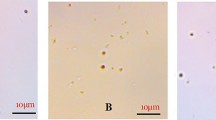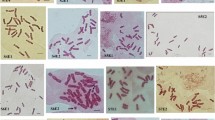Abstract
Ploidy levels of 8 taxa of the genusHieracium subgenusPilosella collected from the same locality were determined by means of flow cytometric estimation of relative nuclear DNA content. The DNA anaysis of isolated nuclei stained with propidium iodide was performed with a flow cytometer equipped with an argon-ion laser. The diploid speciesH. lactucella (2n=18) was used as internal standard. As a rule 20 individuals per taxon were analysed. The flow cytometric analysis proved to be a rapid, accurate and sensitive method for screening of ploidy levels. Considering the known cytological data, the following ploidy levels were determined:H. aurantiacum 4x,H. pilosella 4x,H. piloselloides 4x,H. bauhini 5x,H. caespitosum 5x,H. stoloniflorum 4x,H. brachiatum 4x and 6x,H. leptophyton 7x.H. piloselloides, H. bauhini andH. caespitosum yield relative DNA contents which are the exact multiples of the haploid DNA content ofH. lactucella. In the case ofH. pilosella the haploid DNA content is lower than that predicted from the diploid, namely 0.43 instead of the expected 0.5. The haploid 1x DNA contents of bothH. brachiatum andH. leptophyton range between the value found forH. pilosella and those for the other investigated species, confirming their hybrid origin.
Similar content being viewed by others
References
Bergounioux C. &Brown S.C. (1990): Plant cell cycle analysis with isolated nuclei. In:Darzynkiewicz Z. &Crissman H.A. (eds.),Methods in cell biology 33, Academic Press, New York, pp. 563–573.
Butterfass Th. (1994): Chloroplast numbers per cell and cell volumes in apomicticHieracium polyploids (Asteraceae).Cytologia 59: 231–235.
Dabrowska J. (1992): Chromosome number and DNA content in taxa ofAchillea L. in relation to the distribution of the genus.Prace Bot. Univ. Wroclawsk. 49: 1–84.
Darzynkiewicz Z., Traganos F., Kapuscinski J, Staiano-Coico L. &Melamed M.R. (1984): Accessibility of DNA in situ to various fluorochromes: relationship to chromatin chandes during erythroid differentiation of Friend leukemia cells.Cytometry 5: 355–363.
Doležel J. (1991): Flow cytometric analysis of nuclear DNA content in higher plants.Phytochem. Analysis 2: 143–154.
Doležel J. &Göhde W. (1995): Sex determination in dioecious plantsMelandrium album andM. rubrun using high-resolution flow cytometry.Cytometry 19: 103–106.
Gadella Th.W.J. (1984): Cytology and the mode of reproduction of some taxa ofHieracium subgenusPilosella.Proc. Kon. Ned. Akad. Wetensch., C. 87: 387–399.
Gadella Th.W.J. (1992): Notes on some triple and inter-sectional hybrids inHieracium L. subgenusPilosella (sc(Hill) S.F. GrayProc. Kon. Ned. Akad. Wetensch., C. 95: 51–63.
Galbraith D.W. (1990): Flow cytometric analysis of plant genoms. In:Darznnkiewicz Z. &Crissman H.A. (eds.),Methods in cell biology 33, Academic Press, New York, pp. 549–562.
Galbraith D.W., Harkins K.R., Maddox J.M., Ayres N.M., Sharma D.P. &Firoozapy, E. (1983): Rapid flow cytometric analysis of the cell cycle in intact plant tissues.Science 220: 1049–1051.
Gottschlich G. (1987):Hieracium. In:Wagenitz G. (ed.):Hegi, Illustrierte Flora von Mitteleuropa 4/4, Ed. 2, Verlag Paul Parey, Berlin, Hamburg, pp. 1437–1451.
Hopping M.E. (1994): Flow cytometric analysis ofActinidia species.New Zealand J. Bot. 32: 85–93.
Májovský J. et al. (1987):Karyotaxonomický prehlad flóry Slovenska (Karyological survey of the flora of Slovakia). VEDA, VSAV, Bratislava.
Merxmüller H. (1975): Diploide Hieracien.Anales Inst Bot. Cavanilles 32: 189–196.
Nägeli C.W. &Peter A. (1885):Die Hieracien Mittel-Europas 1, R. Oldenbourg, München.
Pogan E. &Wcisło E. (1989): Cytological investigations onHieracium pilosella L. from Poland I. Karyological studies.Acta Biol. Cracov., Ser. Bot. 31: 19–28.
Skalińska M. (1967): Cytological analysis of someHieracium species, subg.Pilosella from mountains of southern Poland.Acta Biol. Cracov., Ser. Bot 10: 127–141.
Turesson B. (1972): Experimental studies inHieracium pilosella L. II. Taxonomy and differentiation.Bot. Not. 125: 223–240.
Zahn K.H. (1922–1930):Hieracium. In:Ascherson P. &Graebner P. (eds.),Synopsis der Mitteleuroäischen Flora 12/1, Gebrüder Bornträger, Leipzig.
Author information
Authors and Affiliations
Rights and permissions
About this article
Cite this article
Bräutigam, S., Bräutigam, E. Determination of the ploidy level in the genusHieracium subgenusPilosella (Hill) S.F. Gray by flow cytometric DNA analysis. Folia Geobot 31, 315–321 (1996). https://doi.org/10.1007/BF02815376
Issue Date:
DOI: https://doi.org/10.1007/BF02815376




